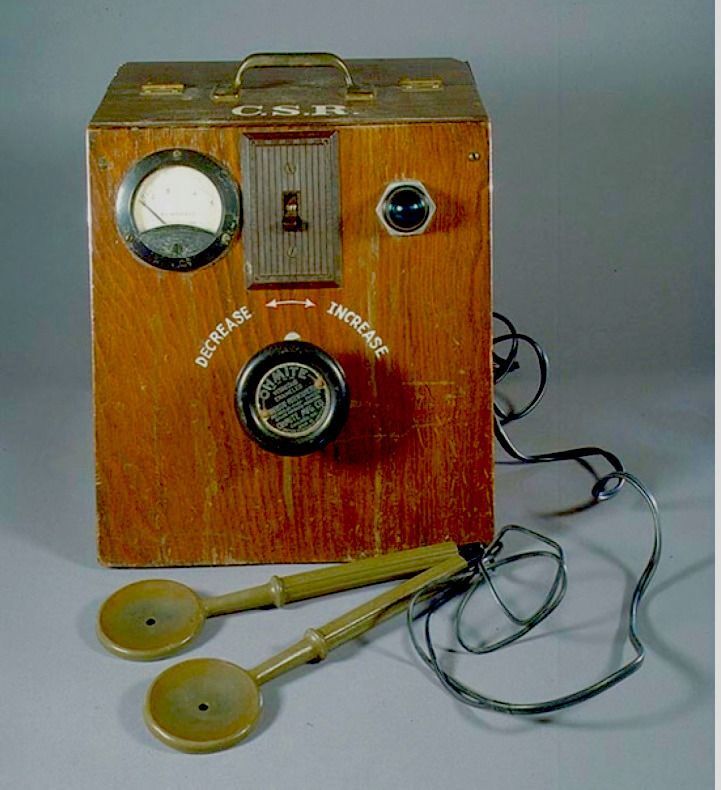
June 1-7 is CPR and AED Awareness Week. In recognition, Starting Hearts will share news, information, and insights on these life-saving medical interventions.
The automated external defibrillator (AED), a marvel of modern medicine and engineering, is crucial for improved out-of-hospital cardiac arrest survival. The small, portable, and easy-to-use device now numbers in the millions across the U.S., providing laypersons with a safe and effective way to help someone whose heart has stopped.
Although efforts to use electric shock on the heart date back over a century, today's AEDs—pulled from walls in airports, shopping malls, schools, and other locations in emergencies— result from decades of experimentation, research, evolution and determination.
Let's visit five key milestones as defibrillation – shocking the heart to restore its normal rhythm – advanced from dubious experiments on animals to sleek modern AEDs.
1. The Dog Days of Defibrillation
In 1899, Swiss physiologists Jean-Louis Prévost and Frédéric Batelli discovered that small electrical shocks could cause irregular heartbeats, known as arrhythmias, in dogs, while larger shocks could reverse the condition.
In decades that followed, as incidence of heart attack and sudden cardiac increased, researchers improved their understanding of arrhythmias and the role electric shock plays in correcting them.
2. The Shock Heard ‘Round the World
In 1947, Cleveland surgeon Dr. Claude Beck competed the first open-heart defibrillation on a human heart.
The patient, a 14-year-old boy undergoing surgery to fix a chest abnormality, experienced ventricular fibrillation, a common and life-threatening arrhythmia. When manually massaging the heart didn’t help, Beck attached two electrodes to the boy’s heart and shocked it four times. His normal heart rhythm was restored, and he recovered.
The story made global headlines and Beck continued work on improving his technique.
3. The External Defibrillator Gets a Human Touch – and Some Wheels
In 1956, Dr. Paul Zoll, a Harvard University cardiologist, led a team that used an external defibrillator for the first time to restore a human heart in ventricular fibrillation. The American Heart Association funded the research.
Zoll, also a pioneer in pacemaker development, later established a company bearing his name that manufactures many of the AEDs used today.
A year following Zoll’s breakthrough, Dr. John Kouwenhoven, PhD, renowned as the ‘Father of Cardiopulmonary Resuscitation’ (CPR), and a team of researchers introduced the first portable external defibrillator. However, the term 'portable' is relative, as the device weighed 200 pounds and required transportation on a wheeled cart.
4. Defibrillators Lighten Up
In 1968, Prof. Frank Pantridge, a Northern Irish cardiologist often called the ‘Father of Emergency Medicine,’ developed the first practical portable external defibrillator.
Clocking in at less than seven pounds and integrating technology developed by NASA, the device served as a precursor to the modern AED. Its lightweight design rendered it effective for responding to cardiac arrests occurring outside of the hospital setting.
5. The Age of the AED Arrives
The AED, as we know it today, began to shape up in Portland, Oregon, during the 1970s.
Physicians Arch Diack and W. Stanley Welborn, along with engineer Robert Rullman, wanted to develop a defibrillator that a layperson with minimal training could use simply and safely.
Their design, The Heart-Aid AED, boasted many features that are standard on today’s AEDs, including adhesive electrode pads and an advanced computer chip for analyzing the victim’s heart rhythm to determine if a shock is needed.
While the Heart-Aid didn't achieve commercial success, it symbolized a significant shift in AED technology: empowering the public to better assist individuals in cardiac arrest.
The dawn of an era marked by improved cardiac arrest survival rates, underscored by the pivotal role played by the public, had arrived.
At Starting Hearts, we can provide you with specific training to save the life of a sudden cardiac arrest victim, as well as lifesaving AEDs.
Contact us for more information: info@startinghearts.org
Patrick Golden is a healthcare writer based in Massachusetts.
